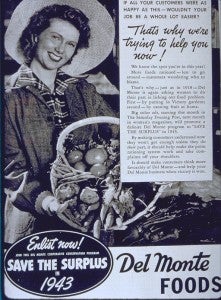 Katharine Kipp, graduate student in the History department at U.C. Davis, shares her thoughts about using advertisements to teach history.
Katharine Kipp, graduate student in the History department at U.C. Davis, shares her thoughts about using advertisements to teach history.
The Marchand Collection features a vast selection of advertisements from various eras. I particularly like those printed during WWII by Del Monte Foods that asked the average citizen, women in particular, to help with the war effort through their consumption habits. I find these ads appealing because they offer an engaging and useful way to discuss the WWII home front. They provide a significant amount of material for students to examine, and do not require reading all of the text in order to fully understand the meaning of the ad as a whole. These images can help enhance lessons covering a wide range of issues.
First, they provide an opportunity for teachers to talk about the role of women on the home front. Typically, classroom discussions draw upon Rosie the Riveter as the primary example of women’s participation in WWII. These ads provide an opportunity to widen the scope on women’s lives during the war. The ads “drafted” female consumers by targeting their domestic sensibilities. They were asked to “Enlist Now!” in an effort to combat the challenges of rationing. Specifically, the ads argue that “Unless You Do Your Part” the rationing system will not work. Essentially these ads help demonstrate the link between a consumer and a patriotic citizen by reminding the audience that purchasing for one’s own self-interest would undermine the war effort. Consumers had to work together with producers to see the nation through the war. Use these ads alone or coupled with war industry ads to discuss the variety of ways women were called upon to contribute to the war effort.
Secondly, teachers can use these ads to help transition to Cold War lessons. They help transition the discussion from self-interest consumption as a potential danger during WWII, to consumption as vital for national stability during the Cold War era.
Finally, I think these ads combined with others from the 1940s and beyond offer an appealing way for students to discuss advertising in general—the importance, pitfalls, and significance. I find ads are a great way to engage students in discussion as they often portray stereotypes and gender roles, provide insight to socioeconomic issues of the era, and offer a glimpse into the mindsets of both the producer and consumer.
Click here to explore more advertising images in the Marchand Archive. How do you use advertisements to teach history? Share your thoughts here.